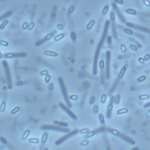Link to Pubmed [PMID] – 19881526
Nat. Genet. 2009 Dec;41(12):1282-9
Reductive evolution and massive pseudogene formation have shaped the 3.31-Mb genome of Mycobacterium leprae, an unculturable obligate pathogen that causes leprosy in humans. The complete genome sequence of M. leprae strain Br4923 from Brazil was obtained by conventional methods (6x coverage), and Illumina resequencing technology was used to obtain the sequences of strains Thai53 (38x coverage) and NHDP63 (46x coverage) from Thailand and the United States, respectively. Whole-genome comparisons with the previously sequenced TN strain from India revealed that the four strains share 99.995% sequence identity and differ only in 215 polymorphic sites, mainly SNPs, and by 5 pseudogenes. Sixteen interrelated SNP subtypes were defined by genotyping both extant and extinct strains of M. leprae from around the world. The 16 SNP subtypes showed a strong geographical association that reflects the migration patterns of early humans and trade routes, with the Silk Road linking Europe to China having contributed to the spread of leprosy.

